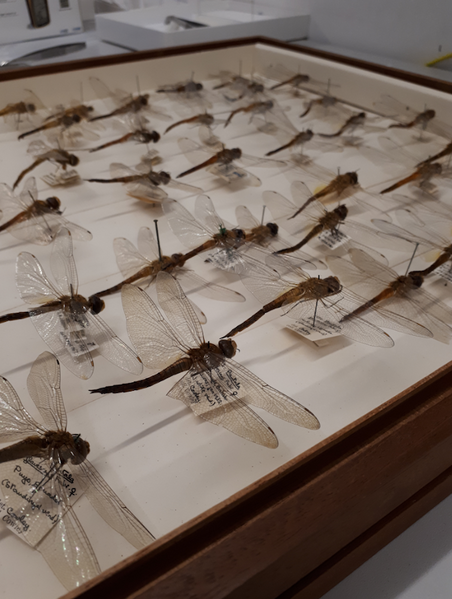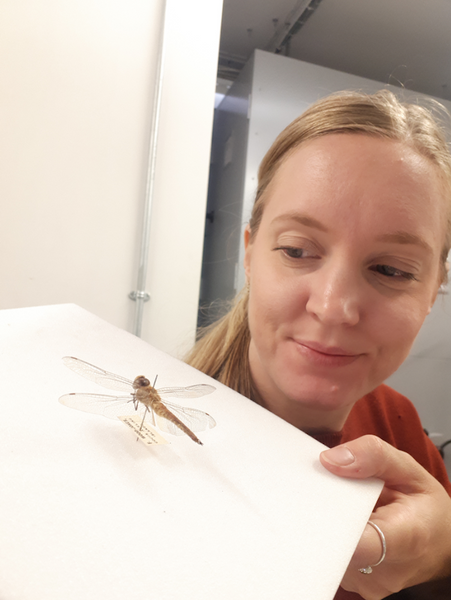top of page
DR JOHANNA HEDLUND
Swedish Research Council Formas fellow
I am a behavioural ecologist in movement ecology, focusing on ecosystems in the sky -the ecological interactions and adaptation of migrant birds and insects. My background is in conservation, having worked for the Swedish government in management of protected areas and species and as a consultant in ecology for e.g. the European Commission. I have a PhD in ethology, researching climate change effects on migratory birds. Going back in my memory, I cannot quite remember what came first, the love of being out in nature or the fear of not growing up fast enough for me to save the cheetah from extinction. It was the great mammalian carnivores that first got my conservation concerns, but it was a drive to understand ecological questions that made me a scientist.
Research on migratory dragonflies
Many of the World’s dragonflies are migratory and may fly long distances seasonally, but very little is known about this behaviour. In Europe, about 21 species of dragonfly are presumed migratory, though we do not know where they go, what may elicit migratory decision, how they navigate and how long distances they travel. This lack of information is severely affecting our ability to understand population changes, range shifts and possible threats to this order of insects. By using stable isotope analysis and citizen science, I aim to bridge this knowledge gap.
Isotopes are alternate forms of chemical elements, and vary naturally in the environment. For example, depending on a region’s rainfall pattern, isotopes of the element hydrogen (H) are present in a certain characteristic compositions. This composition of stable hydrogen isotopes is absorbed by living organisms through the food chain, thereby reflecting their geographical origin. Dragonfly larvae are aquatic, and the stable hydrogen isotopes that are stored in the wings of adult dragonflies have their origin in the freshwater where the adults developed. Thus, by sampling tiny pieces of adult dragonfly wings, the location where the individual was encountered can be compared to where it developed, and a migratory pattern can be inferred. Stable isotopes can be extracted from both live caught (and released) dragonflies, as well as museum specimens.
Forestry and forest conservation management in Sweden
As a conservation specialist at the national Forest Board of Sweden (Skogsstyrelsen), I participated in monitoring protected areas and in the development of best practice for forestry and forest conservation. The majority of Sweden is still covered in forest, but as a large part of these forests are planted for forestry, there is a great need for sustainable management, to increase their biodiversity and protect rare habitats. The Norwegian spruce (Picea abies) is an important forestry species in Sweden and plantations are numerous, but its great numbers and distribution makes it a troublesome species when they out-compete rarer, deciduous trees. Forest fires is another important topic in Sweden. As all forests once were subjected to this disturbance, many specialist species are now rendered endangered as burnt land has become rare due to forestry practices.
Conservation on the island of Gotland, Sweden
As a conservation manager at the county board of Gotland (Länsstyrelsen Gotland), I participated in the development of new conservation plans for protected areas on the island. Gotland is situated in the middle of the Baltic Sea, and once a coral reef, the island has very shallow ground water and mostly consist of lime stone, shaping its unique and fascinating vegetation and landscape. Having been quite isolated from mainland Sweden, several more traditional forestry and agricultural practices have been preserved, thus the island has become a refugium for many species that have lost most of their habitat elsewhere.
Climate change effects on migratory birds
During my PhD I research climate change effects on migratory birds, investigating how reproduction and behaviour may change as a response to earlier spring and land use-change.
Consulting in ecological solutions and conservation, Paris
As a consultant in ecology I worked with knowledge communication to policy makers, identifying, collecting and reporting information in areas of sustainable development, biodiversity, ecology, urban environment etc. Specific projects included conservation synergy between Natura 2000 sites and adjacent conservation initiatives, ex-situ conservation of species in Europe and soil biodiversity. Clients included the European Commission and the European Environmental Agency.
http://ecosystemsinthesky.com/research
bottom of page














